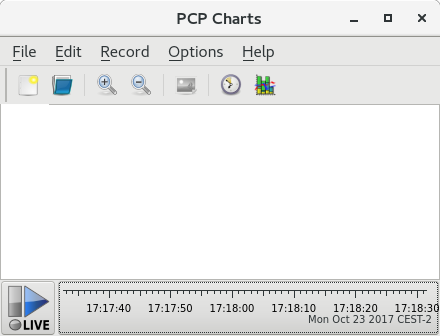Dieser Inhalt ist in der von Ihnen ausgewählten Sprache nicht verfügbar.
5.2. XFS File System Performance Analysis with Performance Co-Pilot
5.2.1. Installing XFS PMDA to Gather XFS Data with PCP
yum install pcp
# yum install pcpsystemctl enable pmcd.service
# systemctl enable pmcd.servicesystemctl start pmcd.service
# systemctl start pmcd.serviceInstalling XFS PMDA Manually
- The
collectorrole allows the collection of performance metrics on the current system
- The
monitorrole allows the system to monitor local systems, remote systems, or both.
both collector and monitor, which allows the XFS PMDA to operate correctly in most scenarios.
cd /var/lib/pcp/pmdas/xfs/
# cd /var/lib/pcp/pmdas/xfs/xfs directory, enter:
5.2.2. Configuring and Examining XFS Performance Metrics
Examining Metrics with pminfo
pminfo tool, which displays information about available performance metrics. The command displays a list of all available metrics provided by the XFS PMDA.
pminfo xfs
# pminfo xfs-t metric- Displays one-line help information describing the selected metric.
-T metric- Displays more verbose help text describing the selected metric.
-f metric- Displays the current reading of the performance value that corresponds to the metric.
-t, -T, and -f options with a group of metrics or an individual metric. Most metric data is provided for each mounted XFS file system on the system at time of probing.
.) as a separator. The leaf node semantics (dots) applies to all PCP metrics. For an overview of the types of metrics that are available in each of the groups, see Table A.3, “PCP Metric Groups for XFS”.
Example 5.1. Using the pminfo Tool to Examine XFS Read and Write Metrics
xfs.write_bytes metric:
pminfo -t xfs.write_bytes
# pminfo -t xfs.write_bytes
xfs.write_bytes [number of bytes written in XFS file system write operations]
xfs.read_bytes metric:
xfs.read_bytes metric:
pminfo -f xfs.read_bytes
# pminfo -f xfs.read_bytes
xfs.read_bytes
value 4891346238
Configuring Metrics with pmstore
xfs.control.reset metric. To modify a metric value, use the pmstore tool.
Example 5.2. Using pmstore to Reset the xfs.control.reset Metric
pmstore with the xfs.control.reset metric to reset the recorded counter values for the XFS PMDA back to zero.
pminfo -f xfs.write
$ pminfo -f xfs.write
xfs.write
value 325262
pmstore xfs.control.reset 1
# pmstore xfs.control.reset 1
xfs.control.reset old value=0 new value=1
pminfo -f xfs.write
$ pminfo -f xfs.write
xfs.write
value 0
5.2.3. Examining XFS Metrics Available per File System
Example 5.3. Obtaining per-Device XFS Metrics with pminfo
pminfo command provides per-device XFS metrics that give instance values for each mounted XFS file system.
5.2.4. Logging Performance Data with pmlogger
pmlogger tool to create archived logs of selected metrics on the system.
/var/lib/pcp/config/pmlogger/config.default. The configuration file specifies which metrics are logged by the primary logging instance.
pmlogger, start a primary logging instance:
systemctl start pmlogger.service
# systemctl start pmlogger.servicesystemctl enable pmlogger.service
# systemctl enable pmlogger.servicepmlogger is enabled and a default configuration file is set, a pmlogger line is included in the PCP configuration:
Modifying the pmlogger Configuration File with pmlogconf
pmlogger service is running, PCP logs a default set of metrics on the host. You can use the pmlogconf utility to check the default configuration, and enable XFS logging groups as needed. Important XFS groups to enable include the XFS information, XFS data, and log I/O traffic groups.
pmlogconf prompts to enable or disable groups of related performance metrics, and to control the logging interval for each enabled group. Group selection is made by pressing y (yes) or n (no) in response to the prompt. To create or modify the generic PCP archive logger configuration file with pmlogconf, enter:
pmlogconf -r /var/lib/pcp/config/pmlogger/config.default
# pmlogconf -r /var/lib/pcp/config/pmlogger/config.defaultModifying the pmlogger Configuration File Manually
pmlogger configuration file manually and add specific metrics with given intervals to create a tailored logging configuration.
Example 5.4. The pmlogger Configuration File with XFS Metrics
pmlogger config.default file with some specific XFS metrics added.
Replaying the PCP Log Archives
- You can export the logs to text files and import them into spreadsheets by using PCP utilities such as
pmdumptext,pmrep, orpmlogsummary. - You can replay the data in the PCP Charts application and use graphs to visualize the retrospective data alongside live data of the system. See Section 5.2.5, “Visual Tracing with PCP Charts”.
pmdumptext tool to view the log files. With pmdumptext, you can parse the selected PCP log archive and export the values into an ASCII table. The pmdumptext tool enables you to dump the entire archive log, or only select metric values from the log by specifying individual metrics on the command line.
Example 5.5. Displaying a Specific XFS Metric Log Information
xfs.perdev.log metric collected in an archive at a 5 second interval and display all headers:
5.2.5. Visual Tracing with PCP Charts
yum install pcp-gui
# yum install pcp-guipmchart command.
pmtime server settings are located at the bottom. The and button allows you to control:
- The interval in which PCP polls the metric data
- The date and time for the metrics of historical data
- Click
to save an image of the current view. - Click
to start a recording. Click to stop the recording. After stopping the recording, the recorded metrics are archived to be viewed later.
- line plot
- bar graphs
- utilization graphs
view, allows the metadata associated with one or more charts to be saved. This metadata describes all chart aspects, including the metrics used and the chart columns. You can create a custom view configuration, save it by clicking view configuration later. For more information about view configuration files and their syntax, see the pmchart(1) manual page.
Example 5.6. Stacking Chart Graph in PCP Charts View Configuration
loop1.
